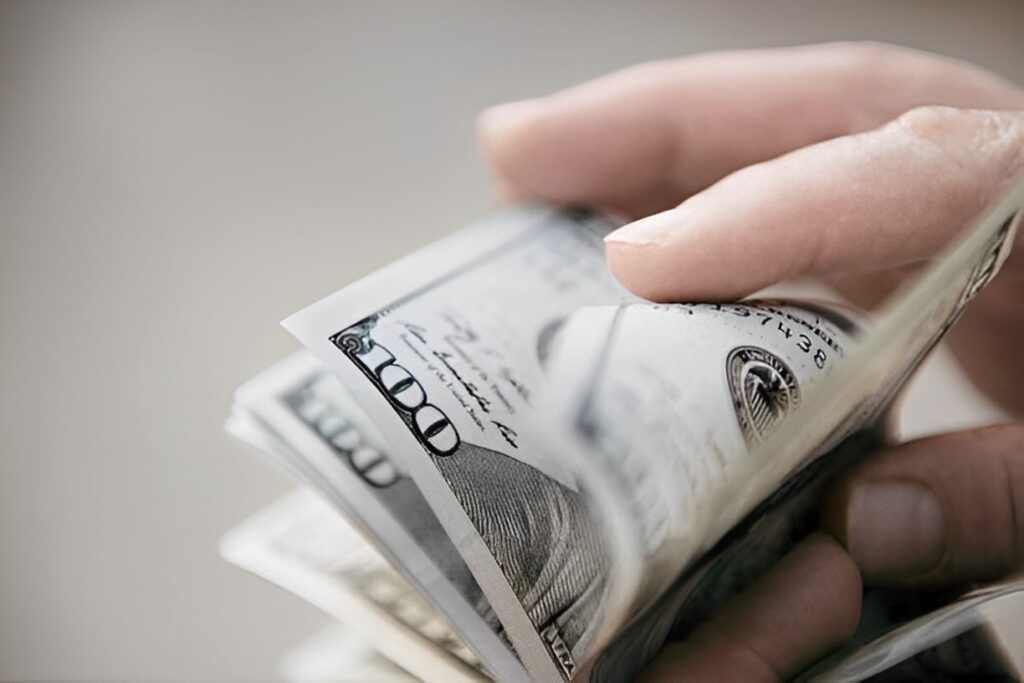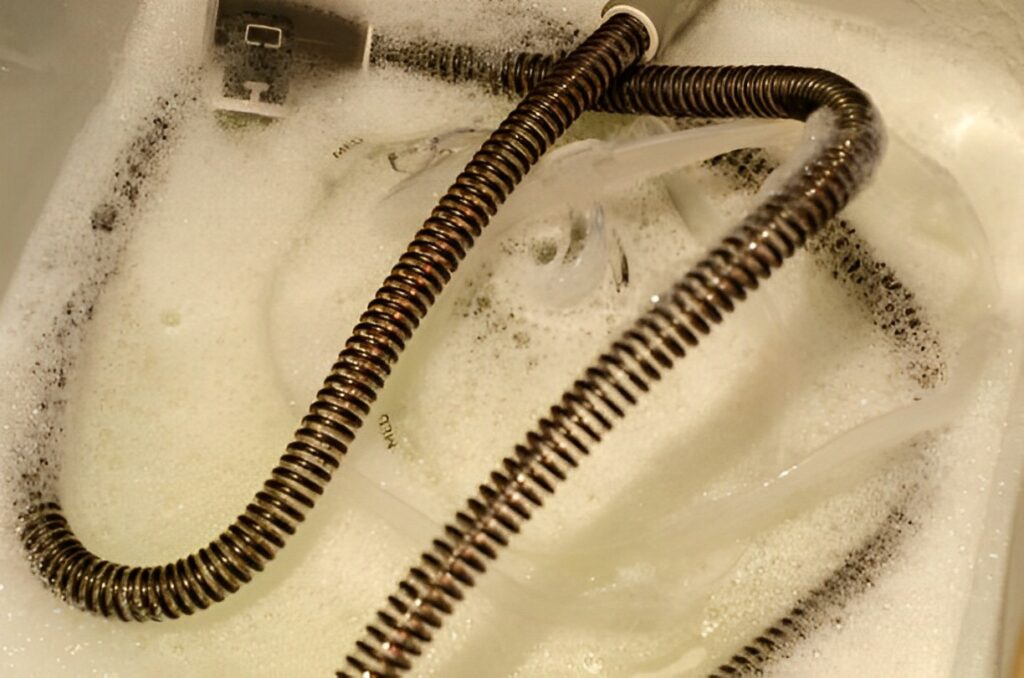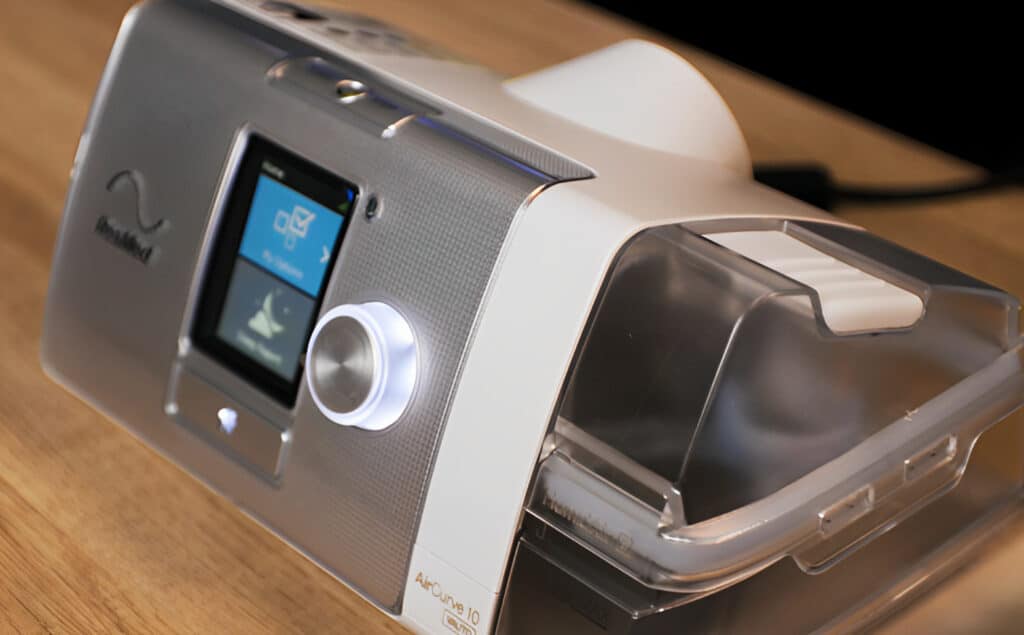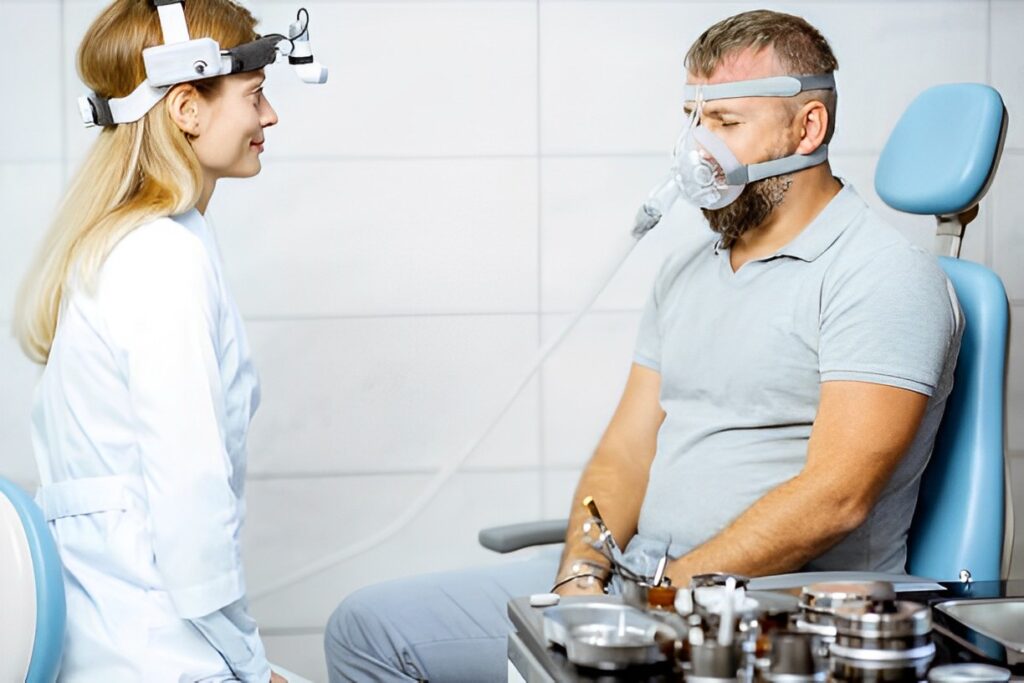CPAP vs BiPAP machine, what are they? Continuous positive airway pressure (CPAP) and bilevel positive airway pressure (BiPAP) are both common ways to treat sleep apnea with positive airway pressure systems. Both processes need the use of apparatus that forces air into the respiratory tract and lungs.
PAP therapy comes in various forms, and while they all perform the same primary purpose, each has its distinct advantages and disadvantages that patients should be aware of. As a result, it’s important to talk to one’s healthcare professional before making any adjustments to one’s PAP therapy.
In this blog post, we will discuss the topic “CPAP vs BiPAP machine”, their definition uses advantages and disadvantages, and many more. Keep reading until the end to find out.
What Is the Difference Between CPAP vs BIPAP Machine?

The main difference between CPAP and BiPAP is that CPAP machines only have one pressure setting. In contrast, bilevel positive airway pressure (BiPAP) machines have separate pressure settings for inhalation and exhalation.
The primary purpose of CPAP machines is to treat obstructive sleep apnea (OSA), while the primary purpose of BiPAP devices is to treat central sleep apnea, complex sleep apnea, or chronic obstructive pulmonary disease (COPD).
CPAP Machine
The pressure of the treatment air delivered by a CPAP machine to the user remains constant, regardless of whether a sleep specialist is manually adjusting the equipment. Most people with obstructive sleep apnea (OSA) use continuous positive airway pressure (CPAP) machines, which keep the air pressure in the patient’s airway constant all night.
BiPAP Machine
A person who uses a BiPAP can adjust it so that the air pressure is higher or lower during the inhale and exhale phases of the breathing cycle. Both are known by their acronyms, which are Inspiratory Positive Airway Pressure and Expiratory Positive Airway Pressure (EPAP). In most cases, the pressures for inhalation during BiPAP therapy are higher than those for exhalation. Exhaling may feel more accessible because of the lower pressure that occurs during that phase of the breath.
Their Difference Regarding Pressure
The air pressure felt during inhalation and exhalation is one of the factors that can vary depending on the type of PAP therapy a patient is receiving.
While the patient is sleeping, CPAP machines apply a consistent pressure to the patient’s airways in order to treat sleep apnea.
On the other hand, BiPAP devices deliver two distinct pressure levels, one level of air pressure for inhalation and another for exhalation. The BiPAP therapy often results in a more significant increase in airflow when the patient is inhaling.
The Cost of CPAP and BiPAP Machine

The cost of CPAP and BiPAP therapy and whether or not insurance will cover it can vary.
The price of CPAP machines can be between $500 and $1,000. The pricing range for BiPAP devices is between $1,700 to $3,000, which is significantly more than the price range for CPAP machines.
Maintenance

These PAP machines are comparable to one another in terms of the maintenance required and the components that make it up. The following are some of the general cleaning instructions that apply to both CPAP and BiPAP machines:
- Cleaning once a week.
- Put the face mask, tubes, CPAP headgear, and plastic connectors in a bowl of warm, soapy water.
- Cleaning the machine using a moist cloth to remove any dust.
- Clear out the filters (if present).
- After reassembly, ensure no air leaks by completely drying the component.
If you have issues with your upper respiratory system, illness, or allergy symptoms, you should use distilled water in your CPAP machine and clean it more frequently. If either machine has mineralization or smells musty, cleaning is necessary.
Related Article: Best Ways To Clean Your CPAP Machine.
What Is BiPAP Machine?

BiPAP is an abbreviation that stands for bilevel positive airway pressure, which simply means that there are two separate degrees of positive airway pressure. The compressed air delivered by a BiPAP machine helps maintain an open airway leading to the lungs. Patients with sleep apnea and others who have trouble breathing while sleeping may be given this or a similar device.
A bilevel positive airway pressure (BiPAP) machine, in contrast to a continuous positive airway pressure (CPAP) machine, pumps air at two different air pressure levels, one for breathing in and another for breathing out.
How Does BiPAP Machine Work?
BiPAP effectively forces pressurized air into the patient’s upper airway. This airflow helps maintain a clear airway, reducing the risk of breathing interruptions, snoring, and other sleep disturbances.
The device creates a higher pressure level in the air and then pumps it through a hose attached to it. On the other end of the hose is a mask that covers either just the mouth or both the mouth and nose. Air goes through the hose and the mask before going into the upper airway, which leads to the lungs.
When the user turns on the BiPAP machine, it exhales at two distinct pressure settings. Inspiratory positive airway pressure, or IPAP for short, is the term used to describe the amount of air pressure delivered to a sleeper while taking in breaths.
In most cases, a BiPAP machine will deliver a higher air pressure when the patient is breathing in and a lower air pressure when breathing out. When treating sleep apnea, the air pressure settings on the BiPAP equipment are really good for maximum efficacy in restoring normal breathing patterns.
The Benefits Of BiPAP Therapy
BiPAP therapy and treatment offers several advantages, including the following:
- The pressure against which a patient exhales can be lowered using a BiPAP machine. This results in better breathing and a reduction in the activation of abdominal muscles, which is beneficial in situations involving weak muscles, inadequate lung expansion, and other similar conditions.
- The limiting of inspiration flow frequently brought on by a collapsed tongue and a restricted upper airway can be combatted with the assistance of a BiPAP machine.
- The dual-mode airflow pressure provided by a BiPAP machine has been demonstrated to deliver more comfortable inhalation and exhalation cycles. Regarding IPAP and EPAP, the dual mode allows for more customization for each patient, resulting in increased patient comfort and an improved pressurization rate.
The Disadvantages of BiPAP
- Irritation of the eyes
- Before receiving approval for a BiPAP, insurance companies must prove that another type of PAP machine has been used.
- Sinus issues
- The BiPAP comes at a higher price than either the CPAP or the APAP.
What is CPAP Machine?

CPAP keeps your airways open for breathing by applying light pressure to the air. To manage breathing problems that occur during sleep, such as sleep apnea, your healthcare practitioner may recommend using CPAP.
How Does CPAP Machine Work?
The CPAP machine takes in air from the environment and cleans and pressurizes it before sending it to you through a tube and a mask. The constant, gentle flow of air helps keep your tongue, uvula, and soft palate from entering your airway too far. Your breathing will become more stable, and the quality of your sleep will increase as a result.
Benefits of CPAP Therapy
CPAP therapy and treatment offers several advantages, including the following:
- The use of CPAP devices has been shown to improve a patient’s overall sleep quality, as well as the speed at which they fall asleep, and to reduce the number of times they wake up during the night to adjust their breathing. In addition to this benefit, CPAP therapy patients report less difficulty staying awake during the day.
- Patients with OSA who use CPAP machines have less snoring. A CPAP machine works to prevent snoring by widening the airway, preventing the muscles in the throat from contracting, and keeping the tongue from falling back to its base, all contributing to snoring. A deflated upper airway and tongue cause snoring.
- It has also been demonstrated that CPAP therapy reduces the risk of cardiovascular illness in OSA patients and lowers the likelihood of inflammation. CPAP therapy has also been shown to minimize the risk of mortality in patients who have suffered an ischemic stroke and to ensure a longer and higher survival rate.
The Disadvantages of CPAP
- The most significant disadvantage of using a CPAP machine is the difficulty in adjusting to the new way of breathing that it requires. Exhaling can be difficult for some people, and it may even cause them to experience feelings of claustrophobia. This is typically the most challenging adjustment to make while using a CPAP mask.
- The pressure setting is fixed.
- When you wear a mask, it might irritate your skin, which can lead to rashes, abrasions, or even skin allergies.
- Your dry mouth may result from an ill-fitting mask or constantly having air blown into your mouth.
When Is a CPAP Prescription Necessary?
For patients with obstructive sleep apnea, CPAP is the treatment of choice, as recommended by the American Academy of Sleep Medicine (AASM). The air pressure generated by the device keeps obstructed airways open, which results in a reduction in snoring, an improvement in the quality of sleep, and a reduction in the severity of daytime symptoms.
Most medical professionals start with a fixed-level CPAP when treating patients with sleep apnea. The results of a person’s sleep study determine the optimal constant pressure setting for that person. For those diagnosed with OSA as well as those suffering from a variety of other diseases, including but not limited to:
- The most severe form of chronic obstructive pulmonary disease (COPD).
- Complications relating to medication or drugs that affect breathing
- A past medical history that includes operations on the upper airway.
Auto-adjusting CPAP may be an option for people with moderate or severe OSA who do not have additional health conditions that affect breathing while sleeping. These additional health concerns include heart disease, diabetes, and obesity. People who have mild OSA or those who are unable to tolerate fixed-level CPAP may also find that APAP is a solution for them.

When is a BiPAP Prescription Necessary?
For individuals who have had difficulty with CPAP therapy, BiPAP may be a viable alternative treatment option because of its proven efficacy in treating specific kinds of central sleep apnea.
People who suffer from obstructive and central sleep apnea are typical candidates for therapy with Bilevel Positive Airway Pressure (BiPAP). Moreover, it is the treatment of choice for central sleep apneas, which relate to a variety of medical conditions that, in turn, can lead to shallow or sluggish breathing when sleeping. These health conditions include the following:
- Central nervous system illnesses, such as multiple sclerosis.
- Diseases of the nervous and muscular systems, such as muscular dystrophy.
- Opioid usage.
- A condition known as a chronic obstructive pulmonary disease (COPD).
People who have been administered CPAP therapy sometimes have difficulty complying with the treatment and cannot keep up with it. In some instances, CPAP therapy is ineffective for treating sleep apnea. BiPAP has the potential to be a viable alternative to CPAP in either circumstance.
CPAP vs BiPAP Machine: Which Is Right For You?

Because it has received the most research attention of all the noninvasive PAP devices, CPAP is typically the first choice when it comes to flow generation therapy for sleep apnea.
It is not unheard of to go through many different masks and a few different CPAP devices before settling on the one that works best for you when trying to locate the ideal CPAP equipment. Even so, it would help if you only moved on to another option before allowing the device and the mask to work for you.
The first time you use a CPAP machine is a new experience, so you should give yourself plenty of time to acclimatize to it. Transitioning from sleeping without a CPAP to sleeping with one can be nerve-wracking and requires some time to adjust. However, once they finally get adequate sleep, most people can successfully use CPAP and even love using it.
If you are unable to tolerate CPAP or if CPAP is unable to treat your sleep apnea adequately, then a doctor may prescribe that you try another type of PAP equipment, such as APAP or BiPAP.
Conclusion
If you are considering a CPAP or BiPAP machine, it is important to understand the difference between the two. This article has given a basic overview of both machines, their benefits and disadvantages, and many more.
If you have any further questions after reading this article, please do not hesitate to contact us for more information. We would be happy to set up a discovery call with you so that we can discuss your individual needs and help you find the best machine for you.
Frequently Asked Questions
Which of the two is larger than the other?
The majority of CPAP and BiPAP machines are about the same size. However, the dimensions can vary slightly depending on the manufacturer and the specific model.
Should I get a prescription from my doctor before purchasing a CPAP machine?
A doctor’s prescription is necessary to receive a CPAP or BiPAP machine. Because of this, it is essential to discuss any problems regarding breathing while sleeping with a qualified medical professional or a specialist in the field of sleep medicine.
Does this article help in your decision regarding PAP treatment? Leave a comment below!



